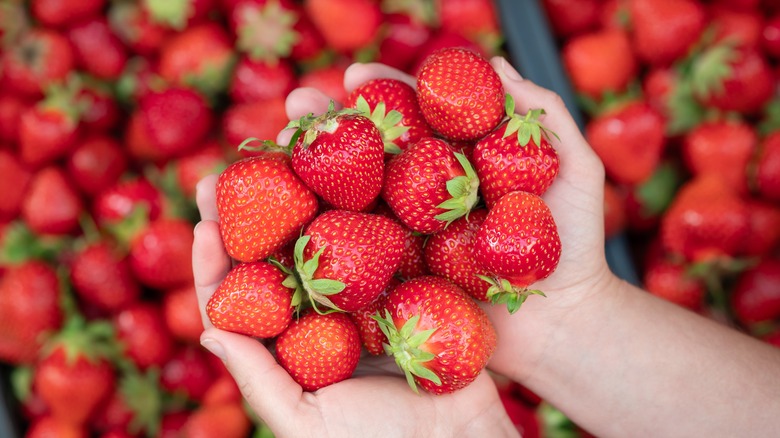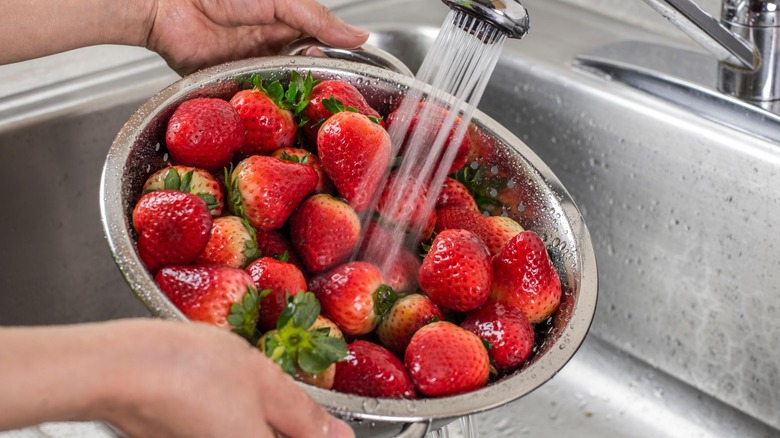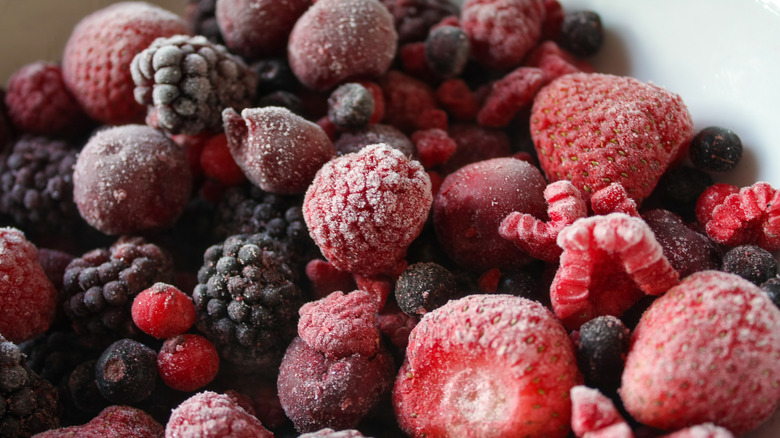The Best Way To Prevent Mold On Fresh Berries
Whether scoring ruby strawberries at a U-pick farm or gallons of blueberries in your own yard, very few things beat fruit fresh off the vine. For the brief window of time they're in season, the getting is good — and nature's candy is best enjoyed by the bucketful. But there is a limit to how much even the most avid berry lover can eat, and if you notice your fresh haul of berries starting to go a little squishy and soggy, you want to act fast to prevent mold from settling in, so as not to waste a single juicy gem.
Of course, you can quickly whip up a cobbler or a batch of berry jam to use large quantities of fresh blueberries, raspberries, blackberries, etc., but freezing them is the perfect option for putting up fresh berries en masse for months to come — and it's a simple act of kindness for future you. When it's the dead of winter and fresh berry season is but a distant memory, there's nothing better than being able to pull out bags of frozen fruit with all that juicy flavor and nutritional value still intact.
Unlike many other home preservation methods like canning and pickling, freezing fresh berries requires no fancy equipment or skills and couldn't be easier or breezier. You'll only need a little freezer space and freezer-safe containers, like baggies or containers, for a quick two-step preserving method that will keep that nasty mold at bay.
Prep, then double freeze for easy-to-work-with berries
To best prep your fruit, pick through and remove any stems or leaves, sort out any unripe berries from the pack, and rinse them clean — laying on towels afterwards and thoroughly patting dry. If you want to chop your strawberries, now is the time to do so versus once they're frozen. Then, once prepped and dry, set the berries in a flat layer on a cookie tray and slide into the freezer for a few hours until fully frozen.
This initial step allows berries to freeze individually versus in large clumps that are hard to break apart and work with later. Once frozen, remove the trays and scoop frozen berries into freezer-safe containers — plastic bags or air-tight containers or jars work well — and return to the freezer until ready to use. Mark the date in permanent marker — they'll be at their best for about 6-8 months.
Freezing slightly alters the texture of many foods, berries included. Don't expect the exact same juicy, off-the-vine texture when using thawed frozen berries. In instances like fruit salads or fruit trays where this difference would be noticeable, you'll still want to use fresh fruit. Frozen berries work beautifully when baked into a cobbler or pie, sprinkled atop oatmeal, dropped into pancake batter, melted down over the stove into a syrupy compote, or you could even a blend a handful into a frozen margarita — the options are vast.
Frozen berries maintain their nutritional benefits
Fresh berries aren't only bursting with flavor and juice, but they're also packed with vitamins and antioxidants when they're harvested ripe. Luckily, freezing essentially halts them in their tracks and preserves all the vitamins and nutrition, meaning their health benefits don't deteriorate even after weeks or months of chilling in the freezer.
Comparatively, buying produce out of season that's shipped sometimes thousands of miles often means you wind up with fruit that was picked before it was ripe and that's lost much of its nutritional value — or was never given time to reach peak ripeness and flavor to begin with. That's just another reason you should buy your produce locally and shop in tune with the seasons whenever possible.
This means, for the top-notch, most nutritious frozen berries, you'll ideally want to start with fresh berries that were locally grown, perhaps sold at your local farmer's market or at least picked in-season. But if you can't get your hands on those, no worries — all fruit is healthy and delicious. No matter the origin of your berries, this double-freeze method is a foolproof way to prevent mold and preserve your fresh berries, saving you money and reducing food waste.


